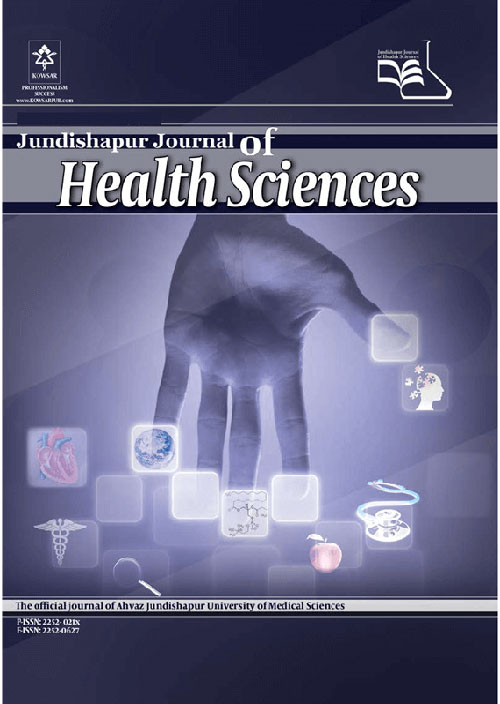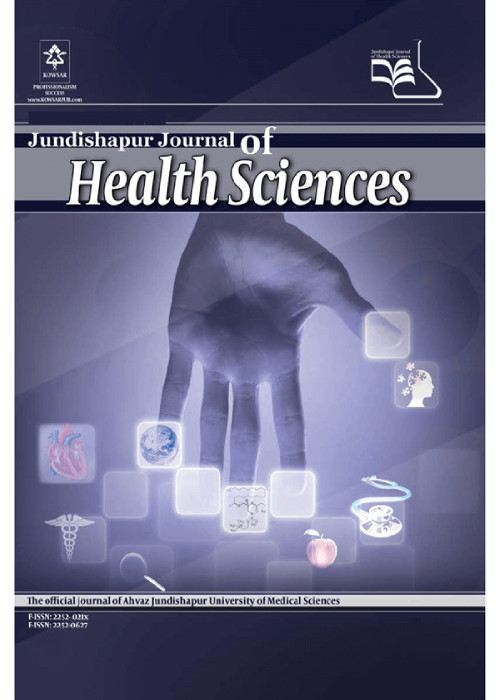فهرست مطالب

Jundishapur Journal of Health Sciences
Volume:13 Issue: 3, Jul 2021
- تاریخ انتشار: 1400/08/09
- تعداد عناوین: 8
-
-
Page 1Context
With the outbreak of COVID-19 pandemic and the rapid growth of online education, Iranian universities of medical sciences began to hold online classes for students. Accordingly, the present study aimed to examine different aspects of online education in medical universities during the COVID-19 pandemic.
MethodsThis narrative review study was to review studies on online education during the COVID-19 pandemic in Iran’s universities of medical sciences. To this end, the PubMed and Sciencedirect databases as well as the Google Scholar scientific search engine were searched on April 20, 2021 using the following keywords: ‘online education,’ ‘virtual education,’ ‘virtual learning,’ ‘e-learning,’ ‘COVID-19,’ and ‘Iran’.
ResultsThe present findings revealed Navid, Adobe Connect, and SkyRoom platforms as the most popular online teaching tools in Iran’s universities of medical sciences during the COVID-19 pandemic. The main challenges in online education in Iranian universities of medical sciences was students’ non-equal accessibility to appropriate hardware, software, and communication tools, students and professors’ insufficient knowledge and unfamiliarity with information technology tools and e-learning, lack of proper interactions between professors and students, and the lack of a suitable platform for practical clinical training and internships.
ConclusionsEducational simulation systems and online education support systems are useful in teaching clinical, practical, and internship courses to students and promoting interactions between teachers and students.
Keywords: Online Education, E-Learning, COVID-19, Iran -
Page 2Background
Tuberculosis (TB) is a major health problem worldwide. To date, the standard diagnostic method for TB is still the direct observation of Mycobacterium TB in a sputum smear or culture.
ObjectivesThere is an urgent need for a method to detect the disease in a shorter time with acceptable sensitivity and specificity and help monitor the treatment.
MethodsA panel of 34 adults newly diagnosed with smear-positive pulmonary TB was followed during their treatment period of five months. Neopterin (NPT) serum levels were measured three times (before treatment and two and five months after treatment) using the Brahms ELItest Neopterin kit, and the results were analyzed using descriptive and graphical methods.
ResultsThe mean NPT for the first time before treatment was 27.47 ± 20.7 nmol/L. NPT was measured two months after the anti-TB treatment, and the associated mean was 16.97 ± 14.14 nmol/L. At the end of the fifth month, the mean NPT concentration reached 11.3 ± 10.5 nmol/L. The mean serum NPT before treatment had a statistically significant difference with the mean NPT at the end of the second and fifth months of the treatment (P = 0.001).
ConclusionsAccording to the national protocol for treating TB, a sputum smear is still necessary for patients’ follow-up. It seems that the serum NPT level should be measured to monitor response to treatment in patients that, for any reason are not able to give sputum in TB treatment follow-up.
Keywords: Neoptrin, Pulmonary Tuberculosis, Monitoring Therapy -
Page 3Background
Depression, stress, and anxiety have a high prevalence among coronavirus disease 2019 (COVID-19) patients, and they can diminish psychological health and lead to malfunctions in various aspects of patients. Mindfulness-based cognitive therapy (MBCT) is considered as one of the effective treatments to improve health-related psychological qualities.
ObjectivesThe current research aimed to determine the effectiveness of the MBCT on depression, stress, and anxiety among people with COVID-19.
MethodsThe research deployed an experimental design with pre-and post-tests and a control group. The population included all recovered patients with COVID-19 referring to health centers in Ahvaz, Iran, in 2020. Using available random sampling method, 30 patients who met the inclusion criteria were recruited and equally randomized into either experimental or control groups. While eight 90-minute MBCT sessions were administered for the experimental group, the control group received no interventions. The Depression, Anxiety, and Stress scale (DASS-21) was used to collect the data. The data were analyzed by SPSS software version 23 using multivariate and univariate analysis of variance.
ResultsThe results showed that there were no significant differences between the two groups in terms of gender, age, and education (P > .05). The results of multivariate analysis of covariance (MANCOVA) and analysis of covariance (ANCOVA) indicated that all the three subscales of depression (d = 0/75), stress (d = 0/86), and anxiety (d = 0/82) were significantly reduced in the intervention group (P < 0.05).
ConclusionsThe MBCT is an effective therapeutic way to reduce depressive, stress, and anxious signs of patients with COVID-19. Thus, it is recommended that therapists and experts use this method to promote patients’ mental health.
Keywords: Mindfulness-Based Cognitive Therapy, Depression, Stress, Anxiety, COVID-19 -
Page 4Background
According to numerous reports, the contamination rates of C. jejuni(C. jejuni) andCampylobacter coli(C. coli) in animal sources, food products, and human clinical specimens were high in Iran.
ObjectivesThis study aimed to estimate the prevalence rate of these bacterial species in Fars province, south of Iran.
MethodsA total of 370 poultry carcasses were randomly collected from five slaughterhouses from January 2019 to June 2019. Using bacteriological and polymerase chain reaction (PCR) methods, we assessed C. jejuni and C. coli contamination rates in the samples.
ResultsBased on the bacteriological results, 203 (54.8%) samples were recognized as Campylobacter species. Also, molecular analysis showed the prevalence of C. coli and C. jejuni in 73 (35.9%) and 130 (64.1%) samples, respectively.
ConclusionsPoultry carcasses are a potential public health risk regarding foodborne campylobacteriosis in south of Iran. Effective control measures and treatment strategies are necessary for poultry farms and slaughterhouses to decrease the transmission and occurrence of campylobacteriosis in human society
Keywords: C. coli, C. jejuni, Prevalence, Poultry Products, Iran -
Page 5Background
During the outbreak of COVID-19 in developing countries such as Iran, the management of healthcare waste has become a very important issue. It is necessary to investigate the risk of virus transmission through direct contact, inhalation, and environmental pollution to reduce transmission risk. The Hazard Analysis of Critical Control Points framework is used to simplify quick responses of waste management for facing the novel infectious disease.
ObjectivesThe aim of this study was to use risk analysis frameworks to describe hazard critical control points (HACCP) and make recommendations and corrective actions for staff who work in healthcare facilities and communities experiencing the COVID-19 outbreak.
MethodsIn the present descriptive-analytical study, a team of environmental health experts identified the critical control points of healthcare waste produced in Razi Hospital and divided them into three categories and six steps. A tested and verified hazard analysis flow diagram was prepared to determine critical points in different steps of healthcare waste management. Critical control points were identified and analyzed by the team at each step. Recommendations and corrective actions were made for each control point.
ResultsThe production rate significantly increased from 580 to 1,733 kg per day, probably caused by the increased use of disposable waste during the pandemic. Transportation, disinfection, and storage appeared to be associated with an individually high level of transmission risk of COVID-19 virus. Also, direct contact with infectious waste was often associated with a high risk of virus transmission. In the final disposal of healthcare waste, people were exposed to a lower level of risk.
ConclusionsTraining staff in different wards of the hospital to use proper personal protective equipment (PPE), hand washing, disinfectants, and ventilation could reduce the risk of COVID-19 transmission through healthcare waste. Using the HACCP method for providing recommendations and corrective actions could simplify responses to reduce the transmission risk of COVID-19 during pandemics.
Keywords: COVID-19, HACCP Method, Healthcare Waste, Hazard Analysis -
Page 7Background
It is essential to decide on where to allocate available resources and identify priorities in noise control.
ObjectivesThis study was performed to prioritize noise control solutions in various units of an oil refinery using the noise control priority index (NCPI).
MethodsThis cross-sectional study was conducted in an oil refinery in 2019. The standard of ISO 91612 was applied in the first stage to assess workplaces and determine the values of the noise pressure level (SPL). The activity of stations and the duration of workers’ presence in these stations were determined via interviews with the supervisors and senior personnel of each unit. The NCPI value in various units was determined using three variables, including the number of exposed people, exposure duration, and the weighting factor related to the sound pressure level (SPL). Finally, units were prioritized based on the final NCPI value.
ResultsTotally, 10 units were assessed based on the ISO9612 standard. The results revealed that 8.09% of the assessed stations were in the safe zone, 62.24% in the warning zone, and 29.66% in the hazard zone. The highest noise emission was related to the NTA unit (98 dB), and the lowest noise emission was observed in the spherical reservoir unit (84 dB). The NTA unit with 12 workers had the highest noise control priority index (1.25) among the units.
ConclusionsThe NCPI index makes it possible to appropriately prioritize noise control solutions in various industrial units and also implement technical and noise control plans in the oil and gas industries.
Keywords: NCPI, Oil refinery, Noise Control, Prioritization -
Page 8Background
Urinary tract infection is one of the most common bacterial infections in children. Zinc is the second most abundant mineral in the body involved in the growth, cell division, and regulation of immune system activity. In studies, zinc administration has been effective in improving pneumonia and gastroenteritis in children, and today, zinc is used to treat acute gastroenteritis in children. Due to the increasing use of various supplements in children and the importance of urinary tract infection and its complications in children.
ObjectivesThis study was performed to compare serum zinc levels between children with febrile urinary tract infection and healthy children.
MethodsIn this case-control study, serum zinc was measured in 60 healthy children and 60 children with febrile urinary tract infection, without any underlying disease, by an Auto analyzer. Data were analyzed by SPSS version 22 software.
ResultsThe difference in serum zinc levels between the two groups was not statistically significant. There was no statistically significant difference in zinc deficiency between the groups. Serum zinc levels were not associated with sex, age, frequency of urinary tract infection, the severity of leukocytosis, the severity of ESR increase, CRP, and length of hospitalization. In the age group of 24 - 72 months, a significant linear relationship was observed between serum zinc levels and weight. The incidence of urinary tract infections was higher in girls, and this difference was statistically significant in all groups, except in age groups 6 - 12 months and above 72 months.
ConclusionsThis study showed that low serum zinc levels did not increase the risk of febrile urinary tract infection in children. Therefore, prescribing zinc supplements to treat or prevent urinary tract infections requires further studies.
Keywords: Zinc, Urinary Tract Infection (UTI), Children


